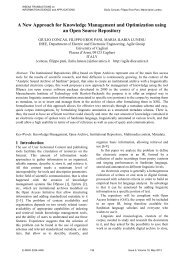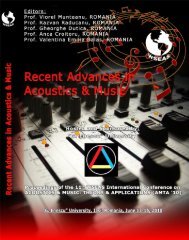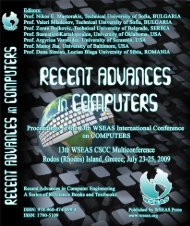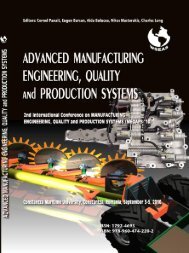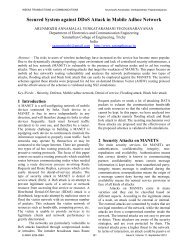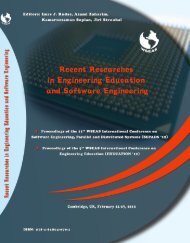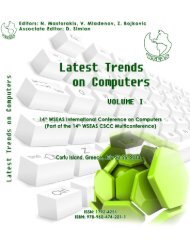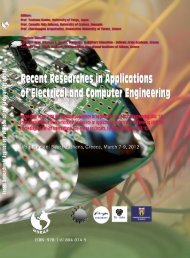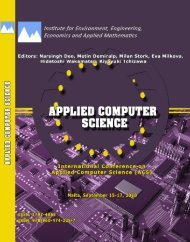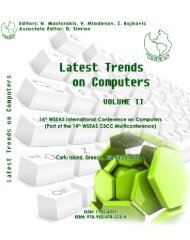RECENT ADVANCES in APPLIED and THEORETICAL ... - Wseas.us
RECENT ADVANCES in APPLIED and THEORETICAL ... - Wseas.us
RECENT ADVANCES in APPLIED and THEORETICAL ... - Wseas.us
- No tags were found...
Create successful ePaper yourself
Turn your PDF publications into a flip-book with our unique Google optimized e-Paper software.
<strong>RECENT</strong> <strong>ADVANCES</strong> <strong>in</strong> <strong>APPLIED</strong> <strong>and</strong> <strong>THEORETICAL</strong> MECHANICSPlenary Lecture 1Boundary Layer Separation Control <strong>in</strong> Turbomach<strong>in</strong>ery Components: A Short Review<strong>and</strong> ExamplesProfessor Pietro Zun<strong>in</strong>oHead of DepartmentDipartimento di Macch<strong>in</strong>e, Sistemi Energetici e TrasportiUniversita di GenovaVia Montallegro 1, I-16145 GenovaE-mail: pietro.zun<strong>in</strong>o@unige.itAbstract: In the last thirty years many efforts have been done to apply flow control devices <strong>in</strong>side a real environment<strong>in</strong> a reliable <strong>and</strong> efficient way. Even though the concept of boundary layer control was <strong>in</strong>troduced by Pr<strong>and</strong>tl at thebeg<strong>in</strong>n<strong>in</strong>g of the 20th century only recently it has been thought to “control” the flow <strong>in</strong>side complex mach<strong>in</strong>e such asaeroeng<strong>in</strong>e. In particular <strong>in</strong>side a modern turbomach<strong>in</strong>e the most <strong>in</strong>terest<strong>in</strong>g application of a boundary layer controldevice is the prevention of flow separation. Boundary layer separation is <strong>in</strong> fact one of the ma<strong>in</strong> ca<strong>us</strong>es of totalpressure losses, moreover the suppression or delay of separation may allow the <strong>in</strong>troduction of moreaerodynamically loaded airfoil <strong>and</strong> surface. In a modern aero eng<strong>in</strong>e this possibility may lead to improvements of theperformances of compressors, turb<strong>in</strong>es <strong>and</strong> diff<strong>us</strong><strong>in</strong>g ducts. For this reason, the experimentation of boundary layerseparation control methods applied to <strong>in</strong>ternal aeroeng<strong>in</strong>e flow becomes of primary importance.Two examples of separat<strong>in</strong>g boundary layers are considered:- lam<strong>in</strong>ar boundary layers on a high lift turb<strong>in</strong>e profile;- turbulent boundary layer on turb<strong>in</strong>e <strong>in</strong>ternal ducts.The strategies for the two cases are different. Lam<strong>in</strong>ar separation may be cured simply by enforc<strong>in</strong>g the boundarylayer transition by means of a passive device enhanc<strong>in</strong>g turbulence production or by means of a synthetic jet.On the contrary turbulent boundary layer separation control requires a large scale momentum transfer to the wall.That can be accomplished by low profile vortex generators.Brief Biography of the Speaker:Laurea <strong>in</strong> Mechanical Eng<strong>in</strong>eer<strong>in</strong>g, University of Genova with honours.Von Karman Institute Diploma Course <strong>in</strong> Turbomach<strong>in</strong>ery with honours.Designer of Turbomach<strong>in</strong>ery at Hydroart S.p.A. (Ansaldo, Riva, Tosi), Milano.Professor of Fluid Mach<strong>in</strong>es at the Faculty of Eng<strong>in</strong>eer<strong>in</strong>g, University of Genova.Head of the Fluid Mach<strong>in</strong>es, Energy Systems <strong>and</strong> Transportation Department, University of Genova.Prof. Pietro Zun<strong>in</strong>o is author of more than 100 scientific papers on flow <strong>in</strong> turbomach<strong>in</strong>es concern<strong>in</strong>g the follow<strong>in</strong>gresearch subjects:- potential flow <strong>and</strong> boundary layers <strong>in</strong> turbomach<strong>in</strong>es;- development of experimental techniques for flow measurements <strong>in</strong> turbomach<strong>in</strong>es (HW, LDA);- experimental analysis of turbulence <strong>and</strong> secondary flows <strong>in</strong> turb<strong>in</strong>e cascades ;- experimental analysis of relative flow <strong>and</strong> turbulence <strong>in</strong> axial <strong>and</strong> centrifugal rotors;- rotor-stator aerodynamic <strong>in</strong>teraction <strong>in</strong> turbomach<strong>in</strong>es;- time vary<strong>in</strong>g wake flow characteristics <strong>and</strong> profile boundary layers <strong>in</strong> turb<strong>in</strong>e cascades;- unsteady aerodynamics of gas turb<strong>in</strong>e premix<strong>in</strong>g burners;- boundary layer separation control.He has been research manager for several research contracts with <strong>in</strong>d<strong>us</strong>tries.He has contributed to several European Research Projects related to the unsteady aerodynamics of aero-eng<strong>in</strong>ecomponents.Prof. Pietro Zun<strong>in</strong>o has been session chairman <strong>in</strong> International Scientific Conferences.He has been scientific reviewer for International Conferences <strong>and</strong> Scientific Journals.He has been <strong>in</strong>dependent evaluator for the European Commission VI <strong>and</strong> VII Framework, Aeronautical <strong>and</strong> Space.ISSN: 1790-2769 11 ISBN: 978-960-474-140-3




